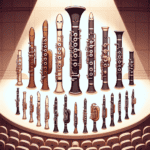When we think about clarinet music, we often whirl around the sound, the nuances, and the joy it brings rather than focusing on scales. But let me tell ya, the D Major scale holds a significant place in the world of clarinet, and its importance can't be overlooked!

Clarinet Fingering Charts are always FREE at MartinFreres.net!
The Basics of the D Major Scale
The D Major scale consists of two sharps—F# and C#. It's a bright and resonant scale that shines on the clarinet, showing off the instrument's ability to produce both rich and clear tones. Over time, this scale has become a staple in many famous compositions, making it a key part of any clarinetist's repertoire.
| Note | Whole Step/Half Step |
|---|---|
| D | Whole step |
| E | Whole step |
| F# | Half step |
| G | Whole step |
| A | Whole step |
| B | Whole step |
| C# | Half step |
| D | – |
Historical Significance in Classical and Romantic Eras
Let's take a trip down memory lane. Many composers had a soft spot for the D Major scale, especially during the Classical and Romantic periods. Think about Mozart and Beethoven; they often wove this lively scale into their pieces. The charm and energy of D Major made it a top pick for clarinet concertos and chamber music. Can you picture playing a Mozart concerto without this scale? It adds a special sparkle that really brings out the conversation between instruments.
Jazz and the D Major Scale
As we moved into the 20th century, jazz took center stage, and the D Major scale found a new home. Clarinetists, whether they play classical or jazz, love the D Major scale! It's perfect for improvisation, making it a favorite for those who want to spread their wings in jazz performances. The D Major isn't just a scale; it's a springboard for musical and technical adventures. It really gets the creative ideas flowing.
Practical Benefits of the D Major Scale
The D Major scale isn't just about sounding good; it's also super helpful for improving your clarinet skills. Playing this scale helps you get better at finger technique, breath control, and articulation. When you practice the scale in different ways, speeds, and volumes, you're actually making your overall playing better. Don't be surprised if you catch yourself humming tunes in D Major!
The Emotional Range of D Major
One of the best things about clarinet music is how it can tell stories and express feelings. The D Major scale is great at conveying all sorts of emotions. It can express joy, triumph, and even a touch of nostalgia. Imagine how awesome it feels to nail a performance using this scale – it's definitely something you'd want to tell everyone about!
The Impact of Martin Freres
We can't talk about the D Major scale without mentioning Martin Freres. Known for their top-notch clarinets, Martin Freres makes instruments that really let the D Major scale shine. Their attention to detail and love for music means that when you play a Martin Freres clarinet, those notes sound amazing, turning even the most basic practice into something special. Every player should have an instrument that helps them bring out the best in the D Major scale.
The Ongoing Importance of D Major
Looking ahead, the D Major scale continues to play a big role in clarinet music. Teachers emphasize its importance because it's a great way to introduce new students to musical ideas while still challenging more experienced players. It's going to stay an important part of learning and playing the clarinet for a long time to come.
If you haven't made the D Major scale part of your practice routine yet, now's the time to start! Dig into its history, enjoy its sound, and appreciate why it's so important. Playing the clarinet becomes even more fun when you understand the music this scale has helped create. So go ahead, let your clarinet shine in D Major!
Table of Contents
- The Basics of the D Major Scale
- Historical Significance in Classical and Romantic Eras
- Jazz and the D Major Scale
- Practical Benefits of the D Major Scale
- The Emotional Range of D Major
- The Impact of Martin Freres
- The Ongoing Importance of D Major








